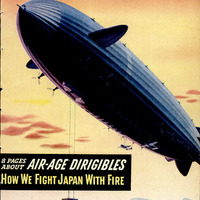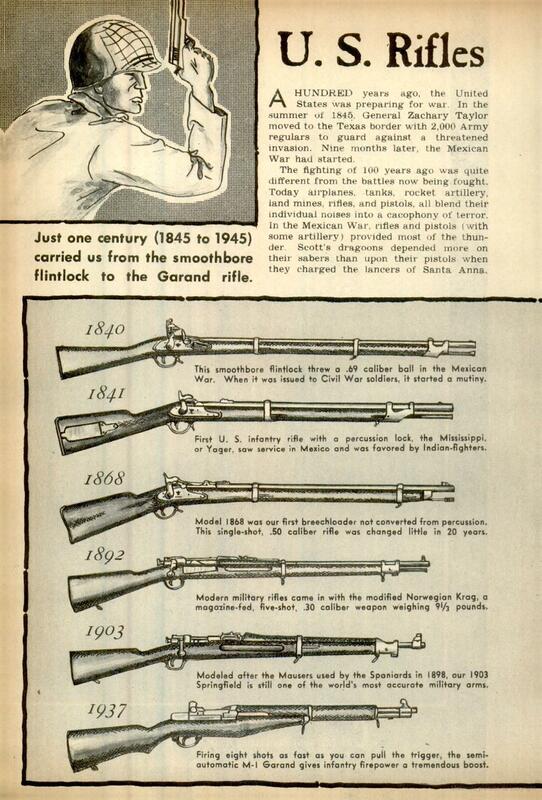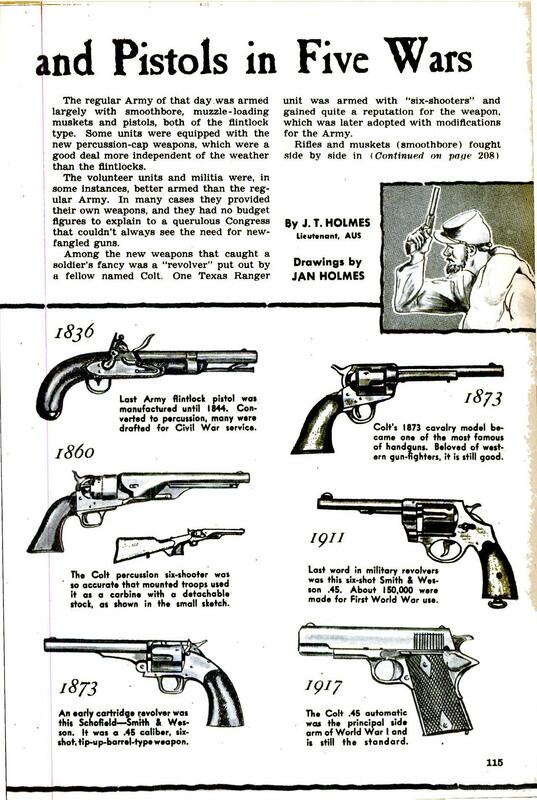-
Title (Dublin Core)
-
U. S. rifles and pistols in five wars
-
Article Title and/or Image Caption (Dublin Core)
-
U. S. rifles and pistols in five wars
-
extracted text (Extract Text)
-
A HUNDRED years ago, the United
States was preparing for war. In the
summer of 1845. General Zachary Taylor
moved to the Texas border with 2,000 Army
regulars to guard against a threatened
invasion. Nine months later, the Mexican
War had started.
The fighting of 100 years ago was quite
different from the battles now being fought.
Today airplanes. tanks, rocket artillery,
land mines, rifies, and pistols, all blend their
individual noises into a cacophony of terror.
In the Mexican War, rifles and pistols (with
some artillery) provided most of the thun-
der. Scott's dragoons depended more on
their sabers than upon their pistols when
they charged the lancers of Santa Anna.
The regular Army of that day was armed
largely with smoothbore, muzzle-loading
muskets and pistols, both of the flintlock
type. Some units were equipped with the
new percussion-cap weapons, which were a
good deal more independent of the weather
than the flintlocks.
The volunteer units and militia were, in
some instances, better armed than the reg-
ular Army. In many cases they provided
their own weapons, and they had no budget
figures to explain to a querulous Congress
that couldn't always see the need for new-
fangled guns.
Among the new weapons that caught a
soldier's fancy was a ‘‘revolver” put out by
a fellow named Colt. One Texas Ranger
unit was armed with “six-shooters” and
gained quite a reputation for the weapon,
which was later adopted with modifications
for the Army.
Rifles and muskets (smoothbore) fought
side by side in
this war. The older smoothbores were prac-
tically useless beyond 50 to 100 yards, and
most battles were fought at close range
with a good deal of bayonet and sword
work involved. The Mexican Army, cor-
ruptly administered, was more poorly
equipped than the American, and practi-
cally every type of shoddy foreign gun could
be found on the battlefields.
The Mexican War brought home the fact
that improvements were necessary in mili-
tary firearms, and inventors were encour-
aged to go to work. The Civil War found
the nation still trying to standardize its
military firearms, however. Probably no
conflict in history has brought together so
many antiquated and modern—for the time
— weapons. Flintlocks, muskets, rifles, re-
peating rifles, single-shot carbines, repeat-
ing carbines; flintlock pistols, “six-shoot-
ers” percussion single-shots, “pepper
boxes,” and derringers faced each other at
Bull Run and Cold Harbor, Gettysburg and
Antietam.
The shortage of manufacturing facilities
on both sides brought about the importation
of foreign arms from Belgium, Germany,
England, and any other nation that had mili-
tary junk to sell. In the end, the industrial
facilities of the North tipped the scales, and
the South was defeated by Yankees firing
guns said to be “loaded on Sunday and fired
all week.”
‘The Civil War spelled the doom of the
muzzle-loader. After the battle of Gettys-
burg in 1863, some 20,000 guns were col-
lected from the battlefield. Examination
at an arsenal showed that anywhere from
two to 23 charges were rammed down one
on top of the other in a very heavy per-
centage of the weapons! It was quite ap-
parent that breechloaders had to be de-
veloped, or half of the soldiers might as
well be armed with sticks. Standardiza-
tion also was decided upon, as investiga-
tion showed some 69 types of rifles being
used, most of them calling for special types
of ammunition.
For economy, many of the old muzzle-
loaders were converted to breechloaders in
the years following the Civil War. The
same was true of pistols, although their
development was ahead of that of the shoul-
der weapons.
In 1873 a new-model, single-shot breech-
loader, which fired a cartridge .45 inch in
diameter, was adopted. This weapon went
through a series of modifications and was
used until about 1892. During all these
years, the Army was experimenting and
testing all types of military rifles and pis-
tols that were being used elsewhere in the
world.
Around the 1890's a board of Army of-
ficers decided to adopt the Norwegian Krag
rifle as the standard infantry arm for the
U.S. This was the first of the .30 calibers,
or “pencil” bullets, as they were called.
The rifle was modified in 1896 and used in
the Spanish-American War.
In this war, the regular Army had the
advantage over the militia and volunteers,
who were largely armed with the older-
model Springfields, which fired the old black-
powder cartridge. Loud laments were heard
every time a round was fired. A cloud of
white smoke gave away the firer’s position
to the Spaniards, who cracked down with
their superior Mausers and smokeless pow-
der.
Following the successful conclusion of
this war, it was decided that we needed a.
rifle incorporating the advantages of the
Mauser with American refinements. The
result was the now famous Model 1903
Springfield, which was the standard infan-
try rifle until the beginning of the pres-
ent war.
A Filipino rebellion next occupied the
Army, and it was found that the .38 caliber
pistols in use did not have sufficient shock-
ing power to stop the fanatical enemy. The
result was the .45 caliber Colt automatic
pistol developed in 1905, which was stand-
ardized with improvements in 1911. This
gun was used through the First World War,
and it is the standard side arm today, al-
though some revolvers are still in use at
the present time.
The First World War did not bring about
any startling developments in rifles or pis-
tols, perhaps because the need for large
quantities of arms enforced standardization.
Because we could not manufacture the
Springfield rifle fast enough to equip our
fast-growing Army, a large proportion of
American infantrymen carried the British
Lee-Enfield. Various types of automatic
weapons were brought out.
America was ready for this war with the
finest semi-automatic rifle in the world. It
was the eight-shot, rapid-fire, accurate Gar-
and. It was a rude shock to a Jap soldier
to wait until five rounds had been fired by
an American soldier and then charge with
the bayonet, only to find that he still faced
a loaded gun. Both the Germans and Jap-
anese have attempted to copy this efficient
weapon, but so far neither has been not-
ably successful.
-
Contributor (Dublin Core)
-
J. L. Holmes (article writer)
-
Jan Holmes (drawings)
-
Language (Dublin Core)
-
eng
-
Date Issued (Dublin Core)
-
1945-05
-
pages (Bibliographic Ontology)
-
114-115,208
-
Rights (Dublin Core)
-
Public domain
-
Archived by (Dublin Core)
-
Sami Akbiyik
-
Marco Bortolami (editor)
 Popular Science Monthly, v. 146, n. 5, 1945
Popular Science Monthly, v. 146, n. 5, 1945




